#react with python backend
Explore tagged Tumblr posts
Text
Unifying Forces: Integrating Python, Node.js, and React for Powerful Web Development

In the rapidly evolving world of web development, the demand for robust and flexible technologies has reached unprecedented heights. As full-stack development gains popularity for its ability to seamlessly combine frontend and backend programming, the integration of Python with Node.js and React has emerged as a dynamic and potent method to create efficient and versatile web applications. This compelling combination offers a multitude of benefits and streamlines the development process, setting the stage for cutting-edge web solutions.
Python, revered for its simplicity and readability, stands as a versatile and widely-used programming language, making it a preferred choice for server-side programming. Meanwhile, Node.js, a powerful runtime environment enabling JavaScript execution on the server side, further amplifies JavaScript's capabilities. On the frontend, React, a JavaScript library developed by Facebook, has revolutionized development with its modular, component-based architecture, facilitating the creation of scalable and maintainable user interfaces.
Together, this integrated trio forms a powerful tech stack that brings forth a host of advantages, enabling developers to craft high-performance and feature-rich web applications. As we dive into the depths of this integration, we will uncover its strengths, explore practical examples, and embrace the immense potential it offers in shaping the future of web development.
Within this article, we will explore the compelling advantages of integrating Python with Node.js and React, examine various integration methods, and delve into practical examples and best practices to leverage this powerful combination for web development projects.
The Potency of Python, Node.js, and React:
1. Python: A Multifaceted Powerhouse Python stands as a high-level, general-purpose programming language celebrated for its readability, simplicity, and versatility. Widely utilized across diverse domains, including web development, data analysis, and artificial intelligence, Python excels at server-side programming. Its extensive library ecosystem and web frameworks like Django and Flask make it a prime choice for backend development.
2. Node.js: Unleashing Speed and Scalability Node.js serves as a runtime environment empowering JavaScript execution on the server side, offering unrivaled speed and scalability. With a non-blocking, event-driven I/O model, Node.js effortlessly handles concurrent connections, making it the go-to solution for real-time applications like chat systems and online gaming.
3. React: Elevating Frontend Development React, developed and maintained by Facebook, introduces a component-based architecture that has taken the frontend development world by storm. This approach allows developers to create reusable UI components, managing complex application states efficiently. Virtual DOM implementation enhances performance by minimizing unnecessary re-rendering, guaranteeing a smooth user experience.
The Synergy of Integration:
When Python, Node.js, and React synergize, developers gain a comprehensive solution for full-stack web development. React with python backend prowess in server-side programming meshes seamlessly with Node.js' speed and scalability, while React's component-based UI development elevates the frontend. This versatile integration allows full-stack programmers to leverage the strengths of each technology and create efficient, maintainable, and high-performance web applications.
Advantages of Integration:
1. Versatility: Uniting Python, Node.js, and React allows developers to tap into their unique capabilities, delivering a complete web application solution. Python manages server-side programming and data manipulation, Node.js facilitates JavaScript on the server, and React simplifies interactive UI creation. This flexibility empowers companies to hire full-stack programmers with expertise in these technologies.
2. Scalability: Both Python and Node.js offer exceptional scalability and performance. Asynchronous libraries and web frameworks in Python handle concurrent requests efficiently, while Node.js' event-driven, non-blocking I/O excels in high-performance applications. React's virtual DOM and efficient rendering ensure frontend responsiveness as the application grows.
3. Performance: Integrating Python with Node.js and React yields high-performance web applications. Python's optimized libraries and frameworks provide swift server-side processing, complemented by Node.js' non-blocking I/O for quick request handling. React's efficient rendering and component-based architecture guarantee fast, responsive user interfaces.
4. Maintainability: A unified codebase featuring Python, Node.js, and React fosters easy maintenance and updates. React's modular structure of components, coupled with Python's clean and readable syntax, ensures a well-organized and maintainable codebase.
5. Faster Development Process: Full-stack developers proficient in Python, Node.js, and React streamline the development process by simultaneously working on both frontend and backend aspects. This reduction in context switching significantly enhances overall productivity.
Best Practices and Tips for Integrating Python with React and Node.js
Choose the Right Integration Method: Evaluate project requirements, team expertise, and performance considerations before selecting an integration method (RESTful API, GraphQL, or microservices). Each has its pros and cons, so choose wisely.
Use Popular Web Frameworks: For server-side development, rely on well-maintained web frameworks like Flask, Django (Python), and Express (Node.js). These frameworks have strong community support and offer a solid foundation for building robust applications.
Keep Frontend and Backend Decoupled: Maintain a clear separation between frontend and backend components to enhance maintainability, scalability, and flexibility. This allows for easier updates and replacements of individual components without affecting the entire application.
Optimize API Requests: Minimize API requests and data transferred between frontend and backend. Techniques like data caching, pagination, and request throttling can enhance API performance and reduce server load.
Prioritize Application Security: Implement security best practices such as input validation, secure API authentication, and proper error handling. Utilize encryption to protect sensitive data and adhere to the principle of least privilege for user roles and access controls.
Test and Monitor Your Application: Regularly test your application throughout development to identify and address issues and performance bottlenecks. Implement monitoring and logging tools to track application performance and detect potential problems proactively.
Maintain Clean and Organized Code: Write clean, well-structured code and follow consistent coding conventions. This ensures ease of understanding, maintenance, and collaboration, especially when working in a team or on existing projects.
Stay Updated with Trends and Technologies: Continuously learn and adapt to the latest advancements in Python, Node.js, React, and related tools and libraries. Staying up-to-date with best practices and technologies will help you build more efficient, secure, and innovative web applications.
Practical Considerations of Integrating Python with React and Node.js
1. Understand Python and Node.js Roles: Recognize that Python offers extensive libraries and clean syntax, while Node.js excels in handling simultaneous connections for real-time applications.
2. Choose the Right Architecture: Select an architecture that allows seamless communication between Python, Node.js, and React. This could involve using Node.js as a bridge or directly calling Python scripts from the Node.js server.
3. Design Robust APIs: Ensure robust API design to facilitate communication between different parts of your software, offering proper error handling and security features.
4. Select Suitable Libraries and Frameworks: Leverage appropriate libraries and frameworks for Python (e.g., Flask, Django) and Node.js (e.g., Express.js). In React, consider using libraries like Redux and React Router.
5. Prioritize Testing and Debugging: Thoroughly test and debug your integrated application using tools like PyTest (Python), Mocha, and Jest (Node.js), and React testing utilities.
Steps for Building Flask and React Applications
Building Flask and React applications involves the following steps:
1. Set Up Flask Back-End: Install Flask using pip and create a Flask application by defining routes for your application. Use the command "flask run" to start the Flask server.
2. Build the React Front-End: Install Create-React-App to bootstrap a new React application. Create React components as building blocks and run the application using "npm start."
3. Connect Flask and React: Set up CORS in Flask to allow communication with React. Use JavaScript's fetch API or libraries like axios to make HTTP requests from React to the Flask back-end.
Conclusion
Integrating Python with React and Node.js offers a powerful tech stack for web development. By following best practices, considering practical aspects, and building applications step-by-step, developers can create efficient, scalable, and innovative full-stack web applications. This combination of technologies continues to gain popularity among developers and companies, making it a valuable skill for full stack developers in the ever-evolving landscape of web development.
#how to integrate python with react#react python#react and python#react with python backend#python react example#python backend react frontend#node js python integration#python and javascript together#javascript and python together
0 notes
Text
¿React o Django? Diferencias, Ventajas y Desventajas en el Desarrollo Web / React or Django? Differences, Advantages, and Disadvantages in Web Development
Introducción / Introduction
Español: En el desarrollo web moderno, elegir la tecnología adecuada puede marcar una gran diferencia en el éxito de un proyecto. React y Django son dos de las herramientas más populares, cada una con sus propios puntos fuertes y limitaciones. React, una biblioteca de JavaScript, es ampliamente utilizada para construir interfaces de usuario dinámicas y altamente interactivas. Django, por otro lado, es un framework de Python que permite crear aplicaciones web robustas y seguras con rapidez. En este blog, exploraremos las diferencias clave entre React y Django, así como sus ventajas y desventajas, para ayudarte a decidir cuál es la mejor opción según tus necesidades.
English: In modern web development, choosing the right technology can make a significant difference in a project's success. React and Django are two of the most popular tools, each with its strengths and limitations. React, a JavaScript library, is widely used for building dynamic and highly interactive user interfaces. Django, on the other hand, is a Python framework that allows for creating robust and secure web applications quickly. In this blog, we will explore the key differences between React and Django, as well as their advantages and disadvantages, to help you decide which one is the best fit for your needs.
1. Diferencias Fundamentales / Fundamental Differences
Español: La principal diferencia entre React y Django es su propósito y enfoque en el desarrollo web:
React: Es una biblioteca de JavaScript utilizada principalmente para construir interfaces de usuario (UI). React se enfoca en la vista en la arquitectura MVC (Modelo-Vista-Controlador), permitiendo la creación de aplicaciones web dinámicas y de una sola página (SPA). React es ideal para manejar la parte frontal de las aplicaciones web, proporcionando herramientas para crear componentes reutilizables y gestionar el estado de la aplicación.
Django: Es un framework completo de Python diseñado para construir aplicaciones web desde cero. Django sigue la arquitectura MVT (Modelo-Vista-Plantilla) y proporciona todo lo necesario para manejar tanto el backend como el frontend de una aplicación web. Es una opción excelente para proyectos que requieren un sistema de autenticación, bases de datos robustas y administración de contenido.
English: The main difference between React and Django is their purpose and focus in web development:
React: It is a JavaScript library primarily used for building user interfaces (UI). React focuses on the view in the MVC (Model-View-Controller) architecture, enabling the creation of dynamic and single-page web applications (SPA). React is ideal for handling the front end of web applications, providing tools to create reusable components and manage application state.
Django: It is a full-stack Python framework designed to build web applications from scratch. Django follows the MVT (Model-View-Template) architecture and provides everything needed to handle both the backend and frontend of a web application. It is an excellent choice for projects requiring an authentication system, robust databases, and content management.
2. Ventajas de React / Advantages of React
Español:
Interactividad y Dinamismo: React permite crear interfaces de usuario altamente interactivas con actualizaciones en tiempo real sin necesidad de recargar la página completa.
Componentes Reutilizables: Los componentes en React son reutilizables, lo que facilita la creación de elementos UI consistentes y la gestión del código.
Amplia Comunidad y Ecosistema: React cuenta con una gran comunidad y un ecosistema de herramientas y librerías que simplifican el desarrollo, como Redux para la gestión del estado y React Router para la navegación.
Rendimiento: React optimiza automáticamente la actualización de la UI mediante el uso de un DOM virtual, lo que mejora el rendimiento de las aplicaciones.
English:
Interactivity and Dynamism: React allows creating highly interactive user interfaces with real-time updates without needing to reload the entire page.
Reusable Components: Components in React are reusable, making it easier to create consistent UI elements and manage code.
Large Community and Ecosystem: React has a large community and an ecosystem of tools and libraries that simplify development, such as Redux for state management and React Router for navigation.
Performance: React automatically optimizes UI updates using a virtual DOM, improving the performance of applications.
3. Desventajas de React / Disadvantages of React
Español:
Curva de Aprendizaje: Aunque React es flexible, su flexibilidad puede ser una desventaja para principiantes que no estén familiarizados con conceptos como JSX, el DOM virtual y la gestión del estado.
Complejidad de Integración: React se centra únicamente en el frontend, por lo que se requiere la integración con otras tecnologías para manejar el backend, lo que puede aumentar la complejidad del proyecto.
Dependencias Externas: Para desarrollar una aplicación completa, es necesario depender de varias librerías y herramientas externas, lo que puede complicar la gestión del proyecto.
English:
Learning Curve: Although React is flexible, its flexibility can be a disadvantage for beginners who are unfamiliar with concepts like JSX, the virtual DOM, and state management.
Integration Complexity: React focuses solely on the frontend, so it requires integration with other technologies to handle the backend, which can increase project complexity.
External Dependencies: Developing a complete application requires relying on various external libraries and tools, which can complicate project management.
4. Ventajas de Django / Advantages of Django
Español:
Framework Completo: Django es un framework completo que incluye todo lo necesario para el desarrollo de aplicaciones web, desde la autenticación de usuarios hasta la gestión de bases de datos.
Seguridad: Django viene con características de seguridad integradas, como protección contra CSRF, SQL injection y XSS, lo que ayuda a crear aplicaciones web seguras por defecto.
Rapidez en el Desarrollo: Con Django, se puede desarrollar aplicaciones de manera rápida gracias a su enfoque en la reutilización de código, el sistema de administración automático y las migraciones de bases de datos.
Soporte para Proyectos Grandes: Django es ideal para proyectos de gran escala, como redes sociales, plataformas de comercio electrónico y sistemas de gestión de contenido, gracias a su robustez y escalabilidad.
English:
Full-Stack Framework: Django is a full-stack framework that includes everything needed for web application development, from user authentication to database management.
Security: Django comes with built-in security features like protection against CSRF, SQL injection, and XSS, helping to create secure web applications by default.
Rapid Development: With Django, applications can be developed quickly thanks to its focus on code reuse, the automatic administration system, and database migrations.
Support for Large Projects: Django is ideal for large-scale projects such as social networks, e-commerce platforms, and content management systems due to its robustness and scalability.
5. Desventajas de Django / Disadvantages of Django
Español:
Rigidez: Django sigue un enfoque de "una forma correcta de hacer las cosas", lo que puede ser restrictivo para desarrolladores que prefieren más flexibilidad en cómo estructurar su código.
Curva de Aprendizaje para Nuevos Usuarios: Aunque Django es poderoso, la curva de aprendizaje puede ser empinada, especialmente para desarrolladores que no están familiarizados con Python o con los patrones de diseño que utiliza.
Menor Interactividad: Comparado con React, las aplicaciones desarrolladas con Django pueden tener menos interactividad en el frontend, a menos que se integren con librerías de JavaScript.
English:
Rigidity: Django follows a "one right way to do things" approach, which can be restrictive for developers who prefer more flexibility in structuring their code.
Learning Curve for New Users: While Django is powerful, the learning curve can be steep, especially for developers who are not familiar with Python or the design patterns it uses.
Less Interactivity: Compared to React, applications developed with Django may have less interactivity on the frontend unless integrated with JavaScript libraries.
6. ¿Cuándo Usar React o Django? / When to Use React or Django?
Español:
Usa React si:
Necesitas construir una interfaz de usuario interactiva y dinámica.
Estás desarrollando una aplicación de una sola página (SPA).
Quieres utilizar una biblioteca con un amplio soporte y comunidad.
Prefieres trabajar con JavaScript y te interesa mantener el frontend separado del backend.
Usa Django si:
Estás desarrollando una aplicación web completa con backend y frontend integrados.
Necesitas un sistema robusto y seguro con autenticación y gestión de bases de datos.
Prefieres un enfoque de desarrollo rápido con muchas herramientas listas para usar.
Estás construyendo un proyecto de gran escala que requiere escalabilidad y mantenimiento a largo plazo.
English:
Use React if:
You need to build an interactive and dynamic user interface.
You are developing a single-page application (SPA).
You want to use a library with broad support and community.
You prefer working with JavaScript and are interested in keeping the frontend separate from the backend.
Use Django if:
You are developing a complete web application with integrated backend and frontend.
You need a robust and secure system with authentication and database management.
You prefer a rapid development approach with many out-of-the-box tools.
You are building a large-scale project that requires scalability and long-term maintenance.
Conclusión / Conclusion
Español: La elección entre React y Django depende en gran medida de las necesidades específicas de tu proyecto. React es ideal para crear interfaces de usuario dinámicas y modernas, mientras que Django proporciona un framework completo para el desarrollo rápido de aplicaciones web robustas. Si tu enfoque es en la interactividad del frontend, React podría ser la mejor opción. Si buscas una solución integral que incluya tanto el backend como el frontend, Django puede ser la elección correcta.
English: The choice between React and Django largely depends on the specific needs of your project. React is ideal for creating dynamic, modern user interfaces, while Django provides a comprehensive framework for rapidly developing robust web applications. If your focus is on frontend interactivity, React might be the best choice. If you’re looking for an all-in-one solution that includes both backend and frontend, Django could be the right choice.
#React#Django#DesarrolloWeb#WebDevelopment#JavaScript#Python#Frameworks#Librerías#Frontend#Backend#SPA#FullStack#ComparaciónReactDjango#InterfacesDeUsuario#AplicacionesWeb#SeguridadWeb#CurvaDeAprendizaje#RendimientoWeb#TecnologíaWeb#ProyectosWeb#InteractividadWeb
0 notes
Text
Unlock your potential with MMT Institute!
🚀 Dive into the world of web development with our comprehensive courses covering front-end and back-end technologies. From Java to Python, we've got you covered! 🖥️ Elevate your skills and career prospects. Call us at 9644004360 for more information or visit mmtinstitute.in. Take the first step toward a rewarding future in web development with MMT Institute! 💻

1 note
·
View note
Text
Пост знакомство
— Привет!👋 Меня зовут Егор
Возраст оставим в секрете, можете считать, что я либо слишком старый, либо слишком молод :)
Про специальность и работу 💼
Я учусь на айти, работаю так же в IT, в настоящий момент работаю над сайтами и попутно учу backend
Имею скилы: практически все программы office, html, css, javascript, java, python, работа с docker и консолью linux ( в процессе изучения :D )
Учу / Хотел бы выучить
Kotlin, react, c++, bash, 1c
Окей, а теперь про душу и увлечения 🌊
————————
Хобби 🎸
————————
————————————————————————
Я люблю компы и все что с ними связано, как вы могли уже понять ^^ ————————————————————————
Изучение языков 🇬🇧 🇨🇳 Английский b2, самую малость китайского
Пк игры 🕹️ Valorant, minecraft, osu, risk of rain 2
Книги 📚 Люблю книги, может быть позже вы сможете найти отзывы на книги у меня в блоге..
—————————————
Просто факты обо мне ❔
—————————————
—————————————————————————
Я кошатник 🐱
Спокойный 🐍
Амбиверт близкий к интроверту 👤
Люблю эмбиент, но в целом меломан в музыке 🎵
Редко, но люблю убираться и менять обстановку 🗃️
Люблю архитектуру и античность 🏙️
Любитель поразглядывать картины 🖼️
—————————————————————————
Ну вроде все, что пришло в голову то и настрочил, будем знакомы, если есть вопросы, можете смело их задать в комментах тут :)
18 notes
·
View notes
Text

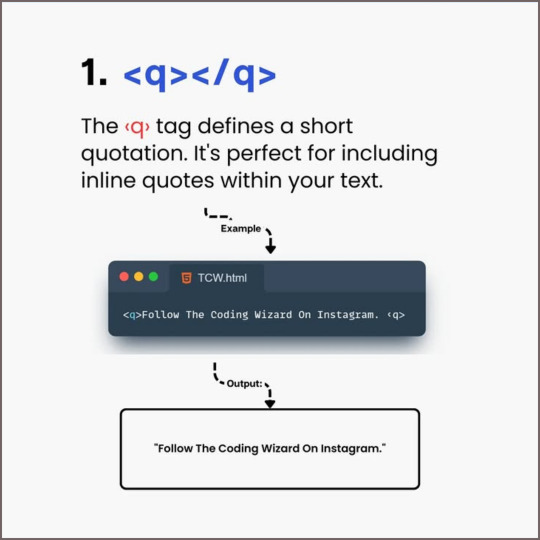
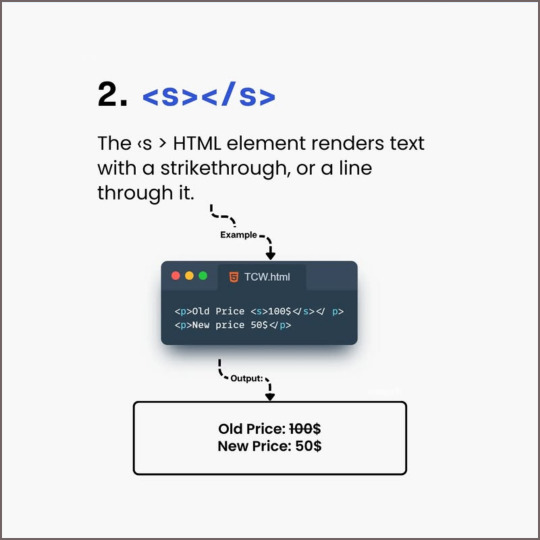
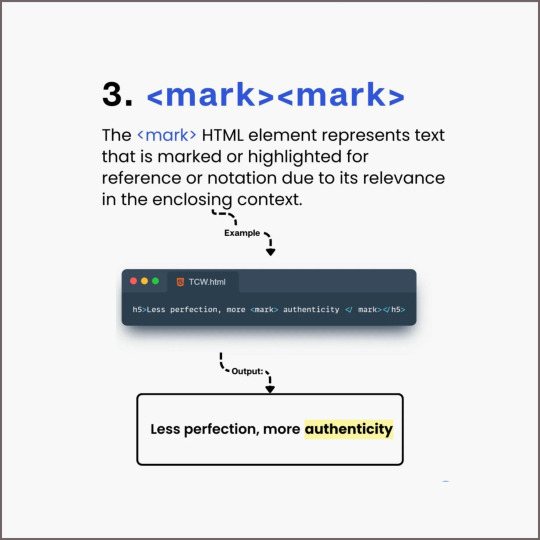
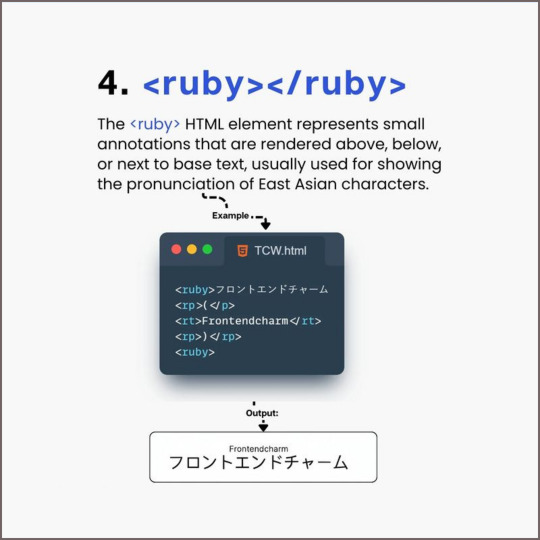
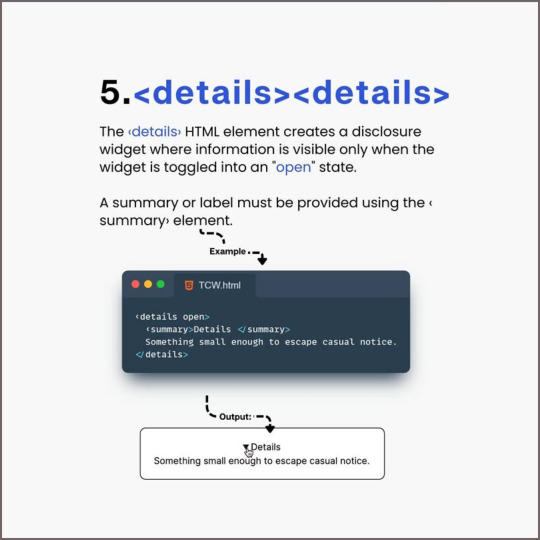
5 Unique HTML Elements You Must Know ⬇️
1.<q></q> 2.<s></s> 3.<mark></mark> 4.<ruby></ruby> 5.<details></details>
html #css #javascript #notes #interview #code #reactjs #react #nodejs #webdeveloper #mern #mean #webdevelopment #developer #coding #mernstack
#programming #python #mongodb #programmer #fullstackdeveloper #node #expressjs #css #angular #webdesign #java #backend #web #frontend
3 notes
·
View notes
Text
Web Designer vs Web Developer : Quelle carrière choisir ?

Avec l’évolution rapide du numérique, les carrières en conception et développement web restent très demandées. Bien que ces deux professions jouent un rôle clé dans la création de sites modernes, elles impliquent des compétences, des responsabilités et des perspectives différentes. Si vous hésitez entre ces deux parcours, ce guide vous aidera à comprendre les différences en termes de rôles, de potentiel de rémunération et d’opportunités à long terme afin de choisir la carrière qui vous convient le mieux.
Que fait un Web Designer ?

Responsabilités principales
Un web designer se concentre sur l’apparence, l’ergonomie et l’expérience utilisateur (UX) d’un site web. Ses tâches incluent :
• Créer des mises en page visuellement attrayantes et des wireframes.
• Sélectionner la typographie, les palettes de couleurs et les éléments de branding.
• Concevoir des sites responsifs et adaptés aux mobiles.
• Utiliser des outils comme Adobe XD, Figma et Sketch.
• Collaborer avec les développeurs pour assurer une bonne transition entre le design et le code.
Compétences clés pour un Web Designer
• Connaissance des principes UI/UX et des meilleures pratiques en ergonomie.
• Maîtrise des logiciels de design graphique (Photoshop, Illustrator, Figma).
• Notions de base en HTML & CSS pour le prototypage.
• Compréhension du branding et de la psychologie des couleurs.
Avantages d’être Web Designer
✔️ Travail très créatif avec une grande liberté artistique.
✔️ Moins de programmation que dans le développement web.
✔️ Forte demande pour l’expertise UI/UX.
✔️ Nombreuses opportunités en freelance, notamment sur des plateformes comme Upwork.
Défis du métier de Web Designer
❌ Rémunération souvent inférieure à celle des développeurs.
❌ Nécessité de suivre en permanence les tendances du design.
❌ Certains clients sous-estiment la valeur du design par rapport au développement.
Que fait un Web Developer ?
Responsabilités principales
Un développeur web est chargé de concevoir et maintenir des sites fonctionnels en utilisant des langages de programmation et des frameworks. Ses missions incluent :
• Écrire et corriger du code pour implémenter des fonctionnalités web.
• Optimiser la vitesse, la sécurité et la scalabilité des sites.
• Gérer les systèmes backend, les bases de données et les API.
• Corriger les bugs et améliorer l’expérience utilisateur.
• Travailler aussi bien sur les technologies front-end que back-end.
Les différents types de développeurs web
• Développeur Front-End : Se concentre sur les aspects visuels et interactifs du site (HTML, CSS, JavaScript).
• Développeur Back-End : Gère la programmation côté serveur, les bases de données et les API.
• Développeur Full-Stack : Maîtrise à la fois le front-end et le back-end.
Compétences clés pour un Web Developer
• Maîtrise de HTML, CSS et JavaScript.
• Connaissance de langages de programmation comme PHP, Python, Ruby.
• Familiarité avec des frameworks comme React, Angular, Vue.js.
• Gestion des bases de données (MySQL, MongoDB).
• Compétences en débogage, tests et gestion de versions.
Avantages d’être Web Developer
✔️ Forte rémunération, en particulier pour les développeurs full-stack et back-end.
✔️ Demande croissante avec de nombreuses opportunités d’évolution.
✔️ Possibilité de travailler sur des projets complexes et de grande envergure.
✔️ Opportunités de travail à distance et en freelance.
Défis du métier de Web Developer
❌ Apprentissage continu indispensable en raison des évolutions technologiques rapides.
❌ Travail très technique avec peu d’aspects créatifs.
❌ Peut impliquer de longues heures de débogage et de résolution de problèmes.
Conclusion
En résumé, si vous aimez la créativité et le design, le métier de web designer pourrait vous convenir. Si vous préférez la programmation et la résolution de problèmes techniques, le développement web est une meilleure option. Quelle que soit votre décision, les deux carrières offrent de nombreuses opportunités dans l’univers du numérique !
Je suis hermane junior Nguessan developpeur web &mobile
Liens linkedIn 👉 : https://www.linkedin.com/in/hermane-junior-nguessan-2a9a05324?utm_source=share&utm_campaign=share_via&utm_content=profile&utm_medium=ios_app
https://www.linkedin.com/in/hermane-junior-nguessan-2a9a05324?utm_source=share&utm_campaign=share_via&utm_content=profile&utm_medium=ios_app

2 notes
·
View notes
Text
What is Mern stack And Its importance? Before that I will Tell you the best institute for Mern stack course in Chandigarh.

What is Mern stack?
MERN Stack is a popular JavaScript-based technology stack used for building full-stack web applications. It consists of four key technologies:
MongoDB: A NoSQL database that stores data in a flexible, JSON-like format.
Express.js: A lightweight and fast backend framework for Node.js.
React.js: A front-end JavaScript library for building user interfaces.
Node.js: A runtime environment that allows JavaScript to run on the server side.
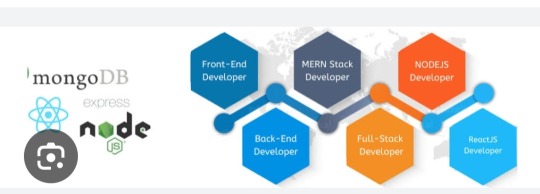
Importance of Mern Stack :
Full-Stack JavaScript – Uses JavaScript for frontend and backend, simplifying development.
High Performance – Node.js ensures fast, scalable applications.
Cost-Effective – Open-source, reducing development costs.
Rapid Development – React’s reusable components speed up UI building.
Flexibility – Suitable for web apps, SPAs, eCommerce, and real-time applications.
Scalability – MongoDB handles large data efficiently.
Strong Community Support – Large developer base ensures continuous updates and support.
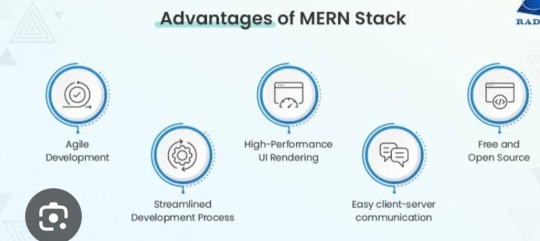
Now i will tell you the best institute for Mern stack course in Chandigarh .
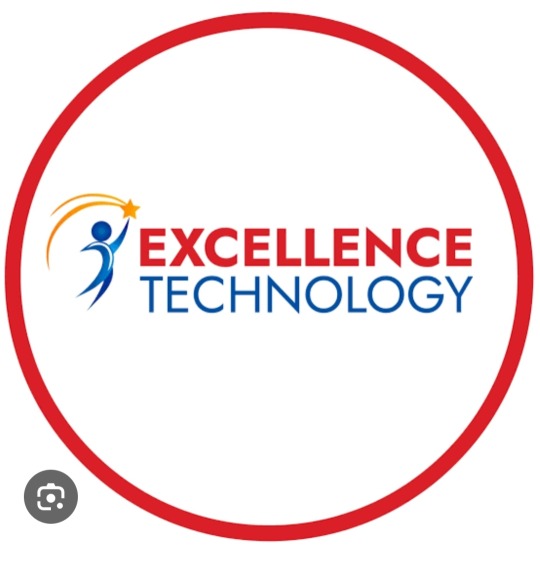
Excellence Technology is a leading EdTech (Educational technology) company dedicated to empowering individuals with cutting -edge IT skills and bridging the gap between education and industry demands. Specializing in IT training ,carrer development, and placement assistance ,the company equipts learners with the technical expertise and practical experience needed to thrive in today's competitive tech landscape. We provide IT courses like python ,Full stack Development, Web Design ,Graphic Design and Digital Marketing.
Contact Us for more details: 93177-88822
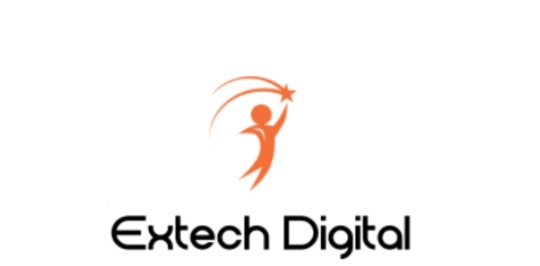
Extech Digital is a leading software development company dedicated to empowering individuals with cutting -edge IT skills and bridging the gap between education and industry demands. Specializing in IT training ,carrer development, and placement assistance ,the company equipt learners with the technical expertise and practical experience needed to thrive in today's competitive tech landscape. e provide IT courses like Python ,Full stack Development, Web Design ,Graphic Design and Digital Marketing.
Contact Us for more details: 93177-88822

Excellence academy is a leading software development company dedicated to empowering individual with cutting edge IT skills and bridging the gap between education and industry demands.specializing in IT training, career development, and placement assistance, the company equits learners with the technical expertise and practical experience needed to thrive in today's landscape. We provide IT courses like python, full stack development,Web design, and Digital marketing.
Contact Us for more details: 93177-88822
About Author
Nikita Thakur
Mern stack AI Developer/ 2+ years of experience
Excellence technology
Professional summary
Nikita thakur is a skilled MERN Stack AI Developer with over 2 years of experience at Excellence Technology. Proficient in MongoDB, Express.js, React.js, and Node.js, she integrates AI solutions to build scalable, high-performance web applications. Nikita excels in developing innovative solutions, enhancing user experiences, and driving business growth through technology.
2 notes
·
View notes
Text
What is SaaS and How to Build a SaaS Platform
What is SaaS? SaaS, or Software as a Service, is a cloud-based software delivery model where applications are hosted online and accessed through the internet. Unlike traditional software that requires installation, SaaS applications run on web browsers, offering convenience and flexibility. The provider manages all technical aspects, including updates, maintenance, and security, while users pay a subscription fee for access.
SaaS is popular for its cost-effectiveness and scalability. Businesses use SaaS for tools like customer relationship management (CRM) systems, project management platforms, and communication solutions. Consumers also rely on SaaS for entertainment and personal productivity.
How to Build a SaaS Platform If you're wondering how to build a SaaS platform, here are the essential steps:
Define Your Purpose: Start by identifying a problem that your SaaS platform will address. Research your audience and focus on a specific niche.
Plan Features: List features that add value, such as easy navigation, integrations, and real-time collaboration. Scalability should also be a priority.
Select the Right Technology: Choose technologies like React for frontend development, Node.js or Python for backend, and cloud hosting platforms like AWS.
Create an MVP: Build a Minimum Viable Product to test your concept, gather feedback, and refine your platform.
Ensure Security: Implement strong encryption, secure authentication, and regular updates to protect user data.
By understanding what SaaS is and following these steps, you can build a successful SaaS platform that meets market needs.
2 notes
·
View notes
Text
Binance clone script — Overview by BlockchainX
A Binance Clone Script is a pre-built, customizable software solution that replicates Binance's features, connect with BlockchainX
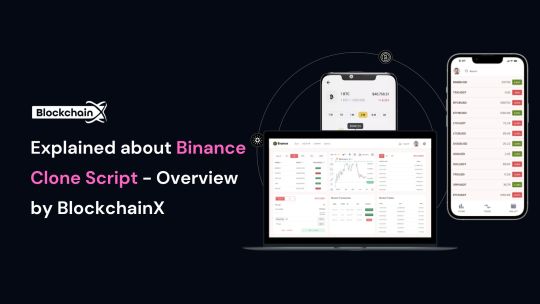
What is Binance Clone Script
A Binance clone script refers to the ready-made solution of the Binance platform that deals with core functions parallel to the widely acclaimed cryptocurrency exchange platform associated with Binance. It enables companies to establish their own platforms like Binance, perfectly parameterized in terms of functionality and user interface of world-famous exchanges. The clone script provides display flexibility with built-in functionality such as spot trading software, futures trading configurations, and wallet systems that are extremely secure.
Basically, it reduces development costs and latency because things like these are already built. And as this is a startup for many young entrepreneurs, they can have saved on their capital to expand or grow their business.
The script is blessed as its feature set caters to future demands in the field. One can enjoy a safe trading experience to customers while ensuring that every peculiarity of Binance’s success opens up to investors of the script.
How does the Binance clone script work?
The Binance clone script works to provide a ready-made platform that replicates Binance’s core features, such as user registration, wallet management, trade and enables users to create accounts, deposit or withdraw cryptocurrency, and trade digital assets through an interface easily and safely. The platform supports various trading methods such as market orders, limit orders and forward trading. It has built-in security features like two-factor authentication (2FA) to save the user money. Admin dashboards allow platform owners to manage users, manage tasks, and set up billing. The script can be tailored to your brand, connecting liquidity sources to make trading more efficient. In short, the Binance clone script provides everything needed to create a fully functional crypto exchange.
key features of a Binance Clone Script
The key features of a Binance Clone Script are designed to make your cryptocurrency exchange platform secure, user-friendly, and fully functional. Here’s a simple overview of these features:
User-Friendly Interface
Multi-Currency Support
Advanced Trading Engine
Secure Wallet System
KYC/AML Integration
Admin Dashboard
Security Features
Trading Options
These features help ensure that your Binance-like exchange is efficient, secure, and ready for the growing crypto market.
Technology Stack Used by BlockchainX
Technology stack used for developing the Binance clone script involves the most advanced technology combination that ensures that the platform must have so much security, scalability, and performance to make it a platform that is secure, scalable, and high-performance as well. Here are a few key technologies and their brief descriptions:
Blockchain Technology:
The underlying part of the cryptocurrency exchange is Blockchain because it ensures the safe and decentralized processing of transactions.
Normally executed on either Ethereum or BSC (Binance Smart Chain) to carry out smart contracts and token transfers.
Programming Languages:
Frontend: For frontend, React or Angular could be engaged in actualization of the user interface leading to a responsive and interactive experience on the various devices.
Backend: In backend, languages like Node.js, Python, or Ruby on Rails can be applied on how internal logic is being run by server and arbitration of user interaction with the module is foremost.
Databases:
These two databases, MySQL or Postgresql, are typically used in user information storage, transaction records, and other exchange information.
NoSQL such as MongoDB or other databases might be used for horizontal scalability and high-volume transaction storage.
Smart Contracts:
It is used to generate and send out smart contracts for auto-trading, token generation, and other decentralized functionalities.
Blockchain Wallets:
Fundamentally, this automatically links famous wallet systems such as MetaMask, Trust Wallet, or Ledger for the secure storage and transactions of cryptocurrency.
Advantages of using a Binance Clone Script
Here are the advantages of using a Binance Clone Script:
Faster Time-to-Market
Cost-Effective
Customizable Features
Liquidity Integration
Multiple Trading Options
So, when entering the marketplace of the cryptocurrencies it would be the most possible work of something to pay off at a rapid pace: the Binance Clone Script proves so.
How to Get Started with BlockchainX’s Binance Clone Script
It is quite a straightforward process to begin working with a BlockchainX Binance Clone Script-this involves the first step of getting in touch with the company for an initial consulting period to understand more about what you require, need, or customize for the site, and what your goals are. When BlockchainX has an understanding of your needs, they offer a detailed list of what a proposal would entail before they can start the work; afterward, they will estimate the costs needed to do the project. Once both sides accept both the presentations and all features and timelines are agreed with, BlockchainX starts working on the development process of building a Binance Clone Script tailored to the brand, user interface, and other features.
After the entire platform is created, it passes through severe testing to ensure that everything functions excellently. Deployment follows the thorough test. BlockchainX customizes your user interface and more extensions, after deployment. BlockchainX also commits to supporting and sustaining your exchange so that it runs successfully and securely.
Conclusion:
At the end, your confusion may as well be cut short. Yes, the Binance Clone Script will be a resilient solution to spark up the exchange platforms synthesizing user-generated cryptocurrency dreams in the blockchain, even without bankroll when it comes to developing the app. Turning with BlockchainX expertise, you can make an adjustment and scale a powerful platform stocked with the likes of Binance that produced Blockchains, while still containing some specific set-ups for your masterpiece. More amazing features are exclusive to the clone script, moreover, such as support for multiple currencies, high-end security, real-time data, and a smooth user interface that completes the trading process for your users without any glitch.
This solution gives easy access to ready-made solutions. It could have quality Depending on the time you conveniently let BlockchainX’s be and use both exchanges or any variation of the two permutations. After all, who decides to couple up with a one-experienced Crypto Exchange developer who is struggling to offer anything new.
#binance clone script#binance clone script development#binance clone script development service#blockchain technology#blockchain#cryptocurrency#cryptocurrencies
2 notes
·
View notes
Text
The Roadmap to Full Stack Developer Proficiency: A Comprehensive Guide
Embarking on the journey to becoming a full stack developer is an exhilarating endeavor filled with growth and challenges. Whether you're taking your first steps or seeking to elevate your skills, understanding the path ahead is crucial. In this detailed roadmap, we'll outline the stages of mastering full stack development, exploring essential milestones, competencies, and strategies to guide you through this enriching career journey.

Beginning the Journey: Novice Phase (0-6 Months)
As a novice, you're entering the realm of programming with a fresh perspective and eagerness to learn. This initial phase sets the groundwork for your progression as a full stack developer.
Grasping Programming Fundamentals:
Your journey commences with grasping the foundational elements of programming languages like HTML, CSS, and JavaScript. These are the cornerstone of web development and are essential for crafting dynamic and interactive web applications.
Familiarizing with Basic Data Structures and Algorithms:
To develop proficiency in programming, understanding fundamental data structures such as arrays, objects, and linked lists, along with algorithms like sorting and searching, is imperative. These concepts form the backbone of problem-solving in software development.
Exploring Essential Web Development Concepts:
During this phase, you'll delve into crucial web development concepts like client-server architecture, HTTP protocol, and the Document Object Model (DOM). Acquiring insights into the underlying mechanisms of web applications lays a strong foundation for tackling more intricate projects.
Advancing Forward: Intermediate Stage (6 Months - 2 Years)
As you progress beyond the basics, you'll transition into the intermediate stage, where you'll deepen your understanding and skills across various facets of full stack development.

Venturing into Backend Development:
In the intermediate stage, you'll venture into backend development, honing your proficiency in server-side languages like Node.js, Python, or Java. Here, you'll learn to construct robust server-side applications, manage data storage and retrieval, and implement authentication and authorization mechanisms.
Mastering Database Management:
A pivotal aspect of backend development is comprehending databases. You'll delve into relational databases like MySQL and PostgreSQL, as well as NoSQL databases like MongoDB. Proficiency in database management systems and design principles enables the creation of scalable and efficient applications.
Exploring Frontend Frameworks and Libraries:
In addition to backend development, you'll deepen your expertise in frontend technologies. You'll explore prominent frameworks and libraries such as React, Angular, or Vue.js, streamlining the creation of interactive and responsive user interfaces.
Learning Version Control with Git:
Version control is indispensable for collaborative software development. During this phase, you'll familiarize yourself with Git, a distributed version control system, to manage your codebase, track changes, and collaborate effectively with fellow developers.
Achieving Mastery: Advanced Phase (2+ Years)
As you ascend in your journey, you'll enter the advanced phase of full stack development, where you'll refine your skills, tackle intricate challenges, and delve into specialized domains of interest.
Designing Scalable Systems:
In the advanced stage, focus shifts to designing scalable systems capable of managing substantial volumes of traffic and data. You'll explore design patterns, scalability methodologies, and cloud computing platforms like AWS, Azure, or Google Cloud.
Embracing DevOps Practices:
DevOps practices play a pivotal role in contemporary software development. You'll delve into continuous integration and continuous deployment (CI/CD) pipelines, infrastructure as code (IaC), and containerization technologies such as Docker and Kubernetes.
Specializing in Niche Areas:
With experience, you may opt to specialize in specific domains of full stack development, whether it's frontend or backend development, mobile app development, or DevOps. Specialization enables you to deepen your expertise and pursue career avenues aligned with your passions and strengths.
Conclusion:
Becoming a proficient full stack developer is a transformative journey that demands dedication, resilience, and perpetual learning. By following the roadmap outlined in this guide and maintaining a curious and adaptable mindset, you'll navigate the complexities and opportunities inherent in the realm of full stack development. Remember, mastery isn't merely about acquiring technical skills but also about fostering collaboration, embracing innovation, and contributing meaningfully to the ever-evolving landscape of technology.
#full stack developer#education#information#full stack web development#front end development#frameworks#web development#backend#full stack developer course#technology
9 notes
·
View notes
Text
So in case you're wondering what I've been up to for the last month or so (no one is here), I've been working on this-
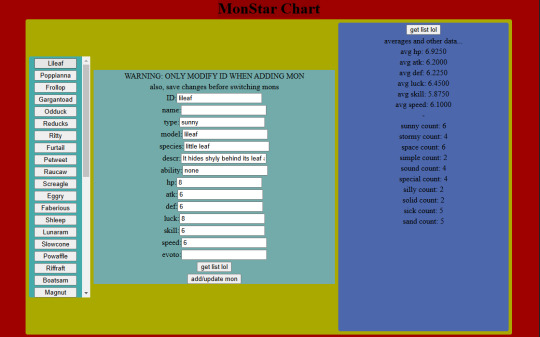
A CRUD app! Because that seems to be what everyone's making these days. It's an editor for monster data. Because, like, all the tutorials were for managing employee data and shit, but this is what data I have that needs managing. It's got a React js frontend and a javascript backend.
It basically runs off this list of data that spawns the entry rows and stuff, so I can add to it easily or reuse the base code between projects:
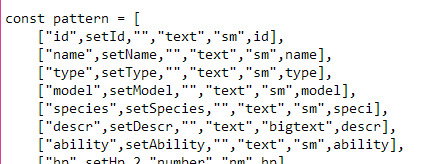
That's neat, but it was a real pain in the ass to have to start up both the client and the server whenever I wanted to use it, so I made basically the same thing but in Python with tkinter:
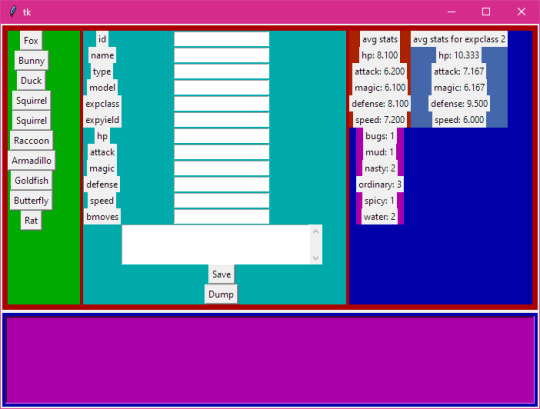
And as an example of reuse here's it being used for moves data-
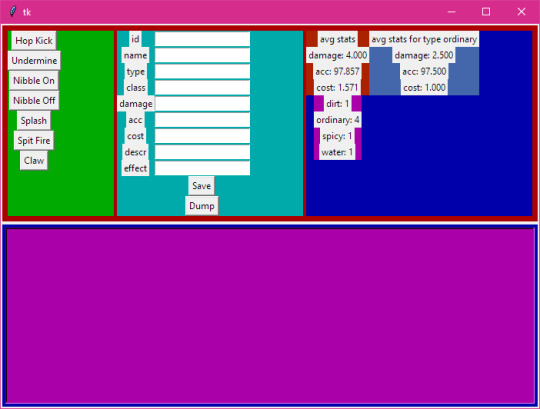
A lot of things are made easier with this. Mainly there's only one data list, whereas the CRUD app needed the state hooks declared, then the data list including the "pointers" to the state variables and setter functions, then the backend needed its own list of the names of the SQL columns.
This version has some extra features like, if you add something to the data list it'll add a column to the SQL database for you. Plus Python is similar to GDScript, so I could bundle a basic version of it with the Mondo code.
Meanwhile I've been upgrading the battle system to handle multiple mons in one battle-
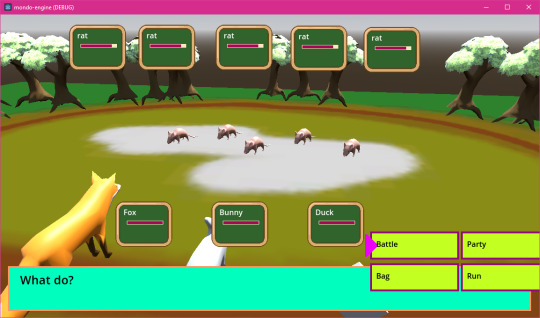
Next I'm probably going to step back a bit and document the code, because it's becoming a bit messy and I need to clean it up
5 notes
·
View notes
Text
Full Stack Testing vs. Full Stack Development: What’s the Difference?

In today’s fast-evolving tech world, buzzwords like Full Stack Development and Full Stack Testing have gained immense popularity. Both roles are vital in the software lifecycle, but they serve very different purposes. Whether you’re a beginner exploring your career options or a professional looking to expand your skills, understanding the differences between Full Stack Testing and Full Stack Development is crucial. Let’s dive into what makes these two roles unique!
What Is Full Stack Development?
Full Stack Development refers to the ability to build an entire software application – from the user interface to the backend logic – using a wide range of tools and technologies. A Full Stack Developer is proficient in both front-end (user-facing) and back-end (server-side) development.
Key Responsibilities of a Full Stack Developer:
Front-End Development: Building the user interface using tools like HTML, CSS, JavaScript, React, or Angular.
Back-End Development: Creating server-side logic using languages like Node.js, Python, Java, or PHP.
Database Management: Handling databases such as MySQL, MongoDB, or PostgreSQL.
API Integration: Connecting applications through RESTful or GraphQL APIs.
Version Control: Using tools like Git for collaborative development.
Skills Required for Full Stack Development:
Proficiency in programming languages (JavaScript, Python, Java, etc.)
Knowledge of web frameworks (React, Django, etc.)
Experience with databases and cloud platforms
Understanding of DevOps tools
In short, a Full Stack Developer handles everything from designing the UI to writing server-side code, ensuring the software runs smoothly.
What Is Full Stack Testing?
Full Stack Testing is all about ensuring quality at every stage of the software development lifecycle. A Full Stack Tester is responsible for testing applications across multiple layers – from front-end UI testing to back-end database validation – ensuring a seamless user experience. They blend manual and automation testing skills to detect issues early and prevent software failures.
Key Responsibilities of a Full Stack Tester:
UI Testing: Ensuring the application looks and behaves correctly on the front end.
API Testing: Validating data flow and communication between services.
Database Testing: Verifying data integrity and backend operations.
Performance Testing: Ensuring the application performs well under load using tools like JMeter.
Automation Testing: Automating repetitive tests with tools like Selenium or Cypress.
Security Testing: Identifying vulnerabilities to prevent cyber-attacks.
Skills Required for Full Stack Testing:
Knowledge of testing tools like Selenium, Postman, JMeter, or TOSCA
Proficiency in both manual and automation testing
Understanding of test frameworks like TestNG or Cucumber
Familiarity with Agile and DevOps practices
Basic knowledge of programming for writing test scripts
A Full Stack Tester plays a critical role in identifying bugs early in the development process and ensuring the software functions flawlessly.
Which Career Path Should You Choose?
The choice between Full Stack Development and Full Stack Testing depends on your interests and strengths:
Choose Full Stack Development if you love coding, creating interfaces, and building software solutions from scratch. This role is ideal for those who enjoy developing creative products and working with both front-end and back-end technologies.
Choose Full Stack Testing if you have a keen eye for detail and enjoy problem-solving by finding bugs and ensuring software quality. If you love automation, performance testing, and working with multiple testing tools, Full Stack Testing is the right path.
Why Both Roles Are Essential :
Both Full Stack Developers and Full Stack Testers are integral to software development. While developers focus on creating functional features, testers ensure that everything runs smoothly and meets user expectations. In an Agile or DevOps environment, these roles often overlap, with testers and developers working closely to deliver high-quality software in shorter cycles.
Final Thoughts :
Whether you opt for Full Stack Testing or Full Stack Development, both fields offer exciting opportunities with tremendous growth potential. With software becoming increasingly complex, the demand for skilled developers and testers is higher than ever.
At TestoMeter Pvt. Ltd., we provide comprehensive training in both Full Stack Development and Full Stack Testing to help you build a future-proof career. Whether you want to build software or ensure its quality, we’ve got the perfect course for you.
Ready to take the next step? Explore our Full Stack courses today and start your journey toward a successful IT career!
This blog not only provides a crisp comparison but also encourages potential students to explore both career paths with TestoMeter.
For more Details :
Interested in kick-starting your Software Developer/Software Tester career? Contact us today or Visit our website for course details, success stories, and more!
🌐visit - https://www.testometer.co.in/
2 notes
·
View notes
Text
reflex.dev
initial thoughts "no state or logic should be on the frontend" is... interesting. the react ecosystem trend feels vvv much like "just dump the entire database into the client and let frontend browser logic do rendering how we want" so it's interesting to see a react derivative that's like well if someone clicks a button we should send it to the server and the server can run the button's onclick and get back to us. bad but interesting
"you shouldn't have to worry about implementation details like what is frontend or backend or what your api calls are". well actually personally i care quite a lot about what the api is.
idk. it's interesting to see people making Intricate Mechanisms in python
fundamentally im not sure why you'd want to use python instead of a .tsx file but hey. ig one advantage is that react doesn't make fetches super easy, iirc you're kinda on your own and have to write a useEffect?
more than anything ig I'm like... why would you want this? why spend time creating this.
the developer docs search is ai enabled which scares me. "why document things if we just throw the codebase in an llm and ask it to lie for us". i guess if devs are using cgpt to help with their projects and you're a new thing, you want to provide an ai helper because cgpt doesn't know about your product and will make shit up entirely
3 notes
·
View notes
Text
The Ultimate Guide to Web Development
In today’s digital age, having a strong online presence is crucial for individuals and businesses alike. Whether you’re a seasoned developer or a newcomer to the world of coding, mastering the art of web development opens up a world of opportunities. In this comprehensive guide, we’ll delve into the intricate world of web development, exploring the fundamental concepts, tools, and techniques needed to thrive in this dynamic field. Join us on this journey as we unlock the secrets to creating stunning websites and robust web applications.
Understanding the Foundations
At the core of every successful website lies a solid foundation built upon key principles and technologies. The Ultimate Guide to Web Development begins with an exploration of HTML, CSS, and JavaScript — the building blocks of the web. HTML provides the structure, CSS adds style and aesthetics, while JavaScript injects interactivity and functionality. Together, these three languages form the backbone of web development, empowering developers to craft captivating user experiences.
Collaborating with a Software Development Company in USA
For businesses looking to build robust web applications or enhance their online presence, collaborating with a Software Development Company in USA can be invaluable. These companies offer expertise in a wide range of technologies and services, from custom software development to web design and digital marketing. By partnering with a reputable company, businesses can access the skills and resources needed to bring their vision to life and stay ahead of the competition in today’s digital landscape.
Exploring the Frontend
Once you’ve grasped the basics, it’s time to delve deeper into the frontend realm. From responsive design to user interface (UI) development, there’s no shortage of skills to master. CSS frameworks like Bootstrap and Tailwind CSS streamline the design process, allowing developers to create visually stunning layouts with ease. Meanwhile, JavaScript libraries such as React, Angular, and Vue.js empower developers to build dynamic and interactive frontend experiences.
Embracing Backend Technologies
While the frontend handles the visual aspect of a website, the backend powers its functionality behind the scenes. In this section of The Ultimate Guide to Web Development, we explore the world of server-side programming and database management. Popular backend languages like Python, Node.js, and Ruby on Rails enable developers to create robust server-side applications, while databases such as MySQL, MongoDB, and PostgreSQL store and retrieve data efficiently.
Mastering Full-Stack Development
With a solid understanding of both frontend and backend technologies, aspiring developers can embark on the journey of full-stack development as a Software Development company in USA. Combining the best of both worlds, full-stack developers possess the skills to build end-to-end web solutions from scratch. Whether it’s creating RESTful APIs, integrating third-party services, or optimizing performance, mastering full-stack development opens doors to endless possibilities in the digital landscape.
Optimizing for Performance and Accessibility
In today’s fast-paced world, users expect websites to load quickly and perform seamlessly across all devices. As such, optimizing performance and ensuring accessibility are paramount considerations for web developers. From minimizing file sizes and leveraging caching techniques to adhering to web accessibility standards such as WCAG (Web Content Accessibility Guidelines), every aspect of development plays a crucial role in delivering an exceptional user experience.
Staying Ahead with Emerging Technologies
The field of web development is constantly evolving, with new technologies and trends emerging at a rapid pace. In this ever-changing landscape, staying ahead of the curve is essential for success. Whether it’s adopting progressive web app (PWA) technologies, harnessing the power of machine learning and artificial intelligence, or embracing the latest frontend frameworks, keeping abreast of emerging technologies is key to maintaining a competitive edge.
Collaborating with a Software Development Company in USA
For businesses looking to elevate their online presence, partnering with a reputable software development company in USA can be a game-changer. With a wealth of experience and expertise, these companies offer tailored solutions to meet the unique needs of their clients. Whether it’s custom web development, e-commerce solutions, or enterprise-grade applications, collaborating with a trusted partner ensures seamless execution and unparalleled results.
Conclusion: Unlocking the Potential of Web Development
As we conclude our journey through The Ultimate Guide to Web Development, it’s clear that mastering the art of web development is more than just writing code — it’s about creating experiences that captivate and inspire. Whether you’re a novice coder or a seasoned veteran, the world of web development offers endless opportunities for growth and innovation. By understanding the fundamental principles, embracing emerging technologies, and collaborating with industry experts, you can unlock the full potential of web development and shape the digital landscape for years to come.
2 notes
·
View notes
Text
A Step-By-Step Guide To Starting Your Developer’s Journey
Giks Canada
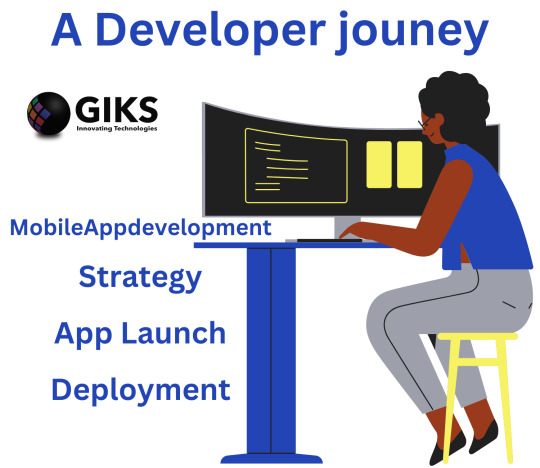
Embarking on Your Developer's Journey: A Step-By-Step Guide
The world of software development is a realm of endless creativity, innovation, and problem-solving. Whether you're just starting out or looking to transition into a tech career, embarking on your developer's journey is an exciting endeavor. From learning the fundamentals to mastering advanced concepts, this step-by-step guide will help you navigate the path to becoming a skilled developer.
Step 1: Define Your Path
Begin by clarifying your goals. Are you interested in frontend or backend development? Mobile apps or web applications? Defining your focus will guide your learning journey.
Step 2: Choose a Programming Language
Select a programming language aligned with your chosen path. For web development, consider languages like HTML, CSS, and JavaScript. For backend development, explore options like Python, Ruby, or Java.
Step 3: Learn the Basics
Start with the basics. Online platforms, coding bootcamps, and tutorials offer beginner-friendly resources to help you grasp programming concepts, syntax, and logic.
Step 4: Build Small Projects
Apply what you've learned by building small projects. These could be simple websites, calculators, or basic apps. Practice is key to solidify your understanding.
Step 5: Explore Frameworks
Frameworks simplify development. For web development, explore frontend frameworks like React or backend frameworks like Django and Ruby on Rails.
Step 6: Version Control with Git
Git is essential for collaboration and version control. Learn the basics of Git and platforms like GitHub to manage your projects effectively.
Step 7: Dive Deeper
As you gain confidence, delve into more advanced topics. Learn about databases, APIs, authentication, and other crucial concepts relevant to your chosen path.
Step 8: Solve Real-world Problems
Challenge yourself with real-world problems. Platforms like LeetCode and HackerRank offer coding challenges that enhance your problem-solving skills.
Step 9: Collaborate and Network
Join coding communities, forums, and meetups. Networking helps you learn from others, get feedback, and stay updated on industry trends.
Step 10: Build a Portfolio
Create a portfolio showcasing your projects. A strong portfolio demonstrates your skills and makes you stand out to potential employers.
Step 11: Seek Internships or Freelance Work
Apply your skills in real-world scenarios through internships or freelance work. Practical experience is invaluable for your growth as a developer.
Step 12: Keep Learning
Technology evolves rapidly. Stay curious and continue learning about new languages, tools, and trends to remain relevant in the field.
Step 13: Specialize
As you gain experience, consider specializing in a niche area like mobile app development, machine learning, or cybersecurity.
Step 14: Contribute to Open Source
Contributing to open-source projects enhances your skills, connects you with the community, and boosts your resume.
Step 15: Stay Adaptable
Adaptability is key in tech. Embrace change, continuously update your skills, and be open to learning new technologies.
In Conclusion
Embarking on your developer's journey requires dedication, perseverance, and a thirst for learning. Remember, every coder started as a beginner. By following this step-by-step guide, you'll lay a strong foundation for your growth as a developer. Stay curious, build, collaborate, and continuously improve – your journey has just begun.
For more information go to my blog website.
2 notes
·
View notes
Text
Master the Code: How Java, Python, and Web Development Tutoring on MentorForHire Can Supercharge Your Tech Career
In a world powered by software, coding is no longer just a niche skill—it's a core competency. Whether you're looking to break into tech, ace a coding bootcamp, land your first junior developer job, or scale your expertise as a senior engineer, personalized mentoring makes a dramatic difference. That’s where MentorForHire.com comes in—a platform that connects you with industry professionals for hands-on Java Tutoring, Python Tutoring, and Web Development Tutoring.
Here’s how specialized tutoring in these key areas can accelerate your learning journey and help you achieve your software development goals.
Why One-on-One Coding Tutoring Beats Generic Online Courses
Self-paced tutorials and free courses are great for dipping your toes in—but when you're serious about growth, they often fall short. Why?
You don’t know what you don’t know.
Debugging can become a time-wasting nightmare.
Without accountability, progress slows down.
You’re not getting job-ready feedback from a real developer.
MentorForHire solves all of these problems by connecting you with real mentors who’ve worked in tech and know what it takes to succeed. Whether you're working on a class assignment, preparing for interviews, or building a full-stack project, you'll get tailored support.
Java Tutoring: Build Enterprise-Grade Skills from the Ground Up
Java isn’t just for beginners—it powers billions of devices, from Android apps to massive backend systems used in finance, healthcare, and e-commerce. If you're serious about software engineering, Java Tutoring offers a rock-solid foundation.
With a mentor, you can:
Understand core concepts like classes, inheritance, interfaces, and exception handling.
Master data structures and algorithms for whiteboard interviews.
Build scalable applications using Java frameworks like Spring and Hibernate.
Get help with unit testing, debugging, and version control.
Prepare for certifications like Oracle Certified Associate (OCA) and Oracle Certified Professional (OCP).
A mentor will not only explain the "how" of Java development but also the "why"—turning you from a coder into a software architect-in-training.
Python Tutoring: The Most Versatile Language in Tech
Python has become the go-to language for beginners and professionals alike because of its simplicity and power. Whether you want to get into automation, data science, machine learning, or back-end web development, Python Tutoring gives you the skills you need to thrive.
On MentorForHire.com, Python mentors can help you:
Write clean, efficient, and maintainable code.
Understand essential concepts like functions, loops, list comprehensions, and file I/O.
Use libraries like NumPy, pandas, Matplotlib, and scikit-learn for data analysis.
Build web apps with Flask or Django from scratch.
Automate tasks using Python scripts or integrate with APIs.
Whether you're solving LeetCode challenges or working on a startup prototype, personalized tutoring can take your Python skills to the next level.
Web Development Tutoring: Learn to Build the Web, Not Just Consume It
Today’s digital economy is built on the web—and web developers are in high demand across every industry. But with so many tools and frameworks, it’s easy to get overwhelmed. That’s where Web Development Tutoring comes in.
From front-end to back-end to full-stack, tutors on MentorForHire.com can guide you step-by-step:
Front-End Skills:
HTML, CSS, and JavaScript fundamentals
Responsive design using Flexbox and Grid
JavaScript frameworks like React, Angular, or Vue
Version control with Git and GitHub
Back-End Skills:
Node.js with Express or Java with Spring Boot
REST APIs and database integration (MySQL, MongoDB)
Authentication systems (OAuth, JWT)
DevOps basics: deploying apps with Heroku or AWS
You’ll work on actual projects like to-do lists, dashboards, or e-commerce stores—and get expert feedback every step of the way.
How MentorForHire Makes Learning Easier and Smarter
MentorForHire.com isn't just about hiring a tutor—it's about mentorship. The platform matches you with experienced developers who offer:
Flexible scheduling – Learn when it suits your life.
Customized roadmaps – No more cookie-cutter syllabi.
Real-world projects – Build apps that solve actual problems.
Code reviews & interview prep – Gain confidence before job applications.
Ongoing support – Whether it’s bugs, burnout, or breakthroughs.
This isn’t a YouTube tutorial or a lecture—it’s a partnership. Whether you're 16 or 60, learning to code becomes faster and more meaningful when you have someone guiding you in real time.
Who Is This For?
Students who want to stand out in their CS classes
Career changers entering tech from another field
Bootcamp grads who need more 1:1 help
Junior developers looking to climb the ladder
Entrepreneurs building their own software products
If you’ve got a goal and a laptop, MentorForHire.com has a mentor ready to help you reach it.
Final Thoughts: The Future Belongs to Lifelong Learners
The best investment you can make is in yourself. Whether you're learning Java, diving into Python, or building full-stack web apps, tutoring turns passive learning into active progress.
MentorForHire.com helps unlock your potential by giving you access to mentors who’ve been where you are—and know how to help you level up.
So why wait? Start your personalized tutoring journey today. Visit MentorForHire and connect with a mentor who can help you write your success story in code.
0 notes